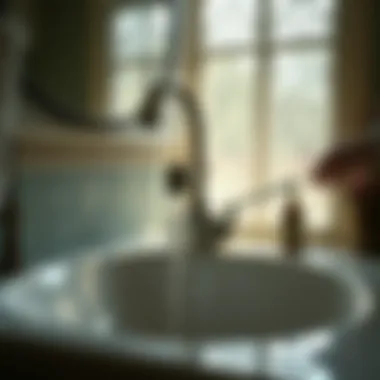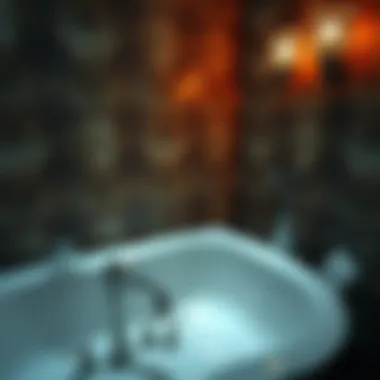Effective Techniques for Cleaning Bathroom Sink Drains


Intro
Keeping a bathroom sink clean is not just about aesthetics; it's also about function and hygiene. Over time, sinks can become breeding grounds for odors, grime, and clogs if not properly maintained. Addressing this issue may seem onerous, but with effective techniques, it can quickly become manageable. In this guide, we’ll walk through various methods to tackle those pesky sink drain problems, focusing on domestic solutions that anyone can implement. From the essential tools to use to preventive strategies that will keep your drain functioning optimally, we aim to arm you with the knowledge needed to ensure your bathroom remains a clean and welcoming space.
We will provide insights on how to effectively clean bathroom sink drains, delve into preventive measures, and explore troubleshooting techniques when routine efforts fall short. Let's set the stage by discussing design inspirations before jumping into the heart of drain upkeep.
Design Inspirations
While a functional sink drain is essential, the overall aesthetic of your bathroom contributes to how enjoyable the space is to use. Creating a harmonious environment can enhance your cleaning routines. Each element, from color choices to layouts, plays a role.
Latest Trends in Bath and Bedroom Design
Modern bathrooms are increasingly embracing minimalist designs with sleek contours and neutral tones. This trend extends to choosing sinks that offer graceful lines while providing easy access for maintenance. Consider models that integrate seamlessly into countertops, which not only enhance the room's look but also minimize nooks and crannies that can harbor grime.
Color Palettes and Themes
Choosing the right colors can influence both the mood and cleanliness perception of your bathroom. Soft hues and muted tones can make a space feel larger and more refreshing. Shades such as muted blues and greens evoke tranquility, while stark whites can suggest cleanliness and clarity. Think about integrating these shades in an intentional manner to foster a space that not only looks good but encourages cleanliness.
Functional Elements
A well-functioning sink and drain are paramount. It is essential to optimize both space and functionality while keeping your design aesthetics in mind.
Space Optimization Tips
To maximize your bathroom sink area, consider using vertical space for storage. Shelving can make it easy to store cleaning supplies nearby while keeping them out of sight. Furthermore, choosing multi-functional pieces, like a sink vanity with built-in storage, can help. This design approach ensures that everything has its place, and there's always a tool handy when the cleaning mood strikes.
Multi-Functional Furniture Choices
Furniture in the bathroom shouldn’t just be pretty; it should also do its part in maintaining cleanliness. Look for items that encourage organization, such as woven baskets under the sink or colorful containers for tools. Investing in a good, versatile sink that may have integrated features like a removable drain cover can streamline cleaning processes.
Ending
By focusing on both design inspirations and functional elements within your bathroom, you set the stage for effective sink maintenance. The next sections will detail specific techniques and step-by-step cleaning processes to ensure your sink drains stay in tip-top shape. Stay tuned as we explore further!
Understanding Sink Drains
Understanding the inner workings of sink drains is crucial for anyone looking to maintain a clean and efficient bathroom. The sink drain is often overlooked, but it plays a vital role in waste disposal and hygiene. Knowing how it functions can not only aid in the cleaning process but also in preventive measures to avoid future issues. By grasping the basics of construction and typical problems, you'll be better equipped to tackle any maintenance tasks that may arise.
Construction and Functionality
Bathroom sink drains are designed to channel wastewater away from your sink. The construction typically involves several parts: the drain itself, the trap, and the pipes leading to the home’s sewage system. The design may seem straightforward—water flows down, while solid debris gets caught in the trap, preventing it from clogging the larger pipes. Recognizing the function of each part helps in identifying where problems may occur. For instance, when drainage issues arise, it's often the trap that's the culprit, harboring everything from hair to soap scum that accumulates over time.
Common Problems with Bathroom Sink Drains
To effectively manage your sink drain, it's important to be aware of common problems that can arise. Understanding these issues can save you time and money, as tackling them early on can help you avoid larger headaches down the line.
Clogs
Clogs are perhaps the most frequent issue faced by bathroom sink drains. They occur when debris, residue, and other materials obstruct the flow of water. One key characteristic of clogs is their unpredictability; they can form suddenly, leaving you with a frustrating sink that refuses to drain. In terms of commonality, clogs are a popular subject of concern because nearly every household experiences them at some point.
- Unique Feature: Clogs can be caused by many factors, such as hair, toothpaste, and soap.
- Advantages/Disadvantages: While the presence of clogs indicates a buildup of materials that need attention, they also signal that the drain's functionality is being compromised. Regular maintenance can reduce the likelihood of a full block, saving your sink from becoming a stagnant pool.


Odors
Odors emanating from sink drains can often indicate problems lurking beneath the surface. The source usually lies in decomposing matter or stagnant water sitting in the trap. One key characteristic of these odors is their unpleasant nature; they can be so pervasive that they affect the overall atmosphere of your bathroom.
- Unique Feature: Unlike clogs, odors are sometimes a sign of a lesser-known issue, such as a broken seal or trap.
- Advantages/Disadvantages: While the odor serves as an alarming indicator of underlying issues, it is beneficial in that it prompts action. Ignoring it can lead to more severe problems, including unsanitary conditions and more costly repairs in the future.
Slow Drainage
Slow drainage is a telltale sign that something isn't right in your sink drain system. This problem often results from partial clogs or buildup within the pipes. The key characteristic of slow drainage is its gradual onset; it may take days or weeks for your sink to exhibit this issue. Many homeowners find it concerning because it suggests that there is an accumulation somewhere within the plumbing.
- Unique Feature: Unlike sudden clogs, slow drainage gives you a window of opportunity to address the problem before it becomes more serious.
- Advantages/Disadvantages: While it is an easier issue to solve than a complete blockage, ignoring the symptoms can undoubtedly lead to worse scenarios in the long run.
Carefully monitoring your sink drain and addressing issues promptly can save both time and money, ensuring that your bathroom remains a clean and functional space.
Preparing for Cleaning
Cleaning your bathroom sink drain is no small task, but taking the time to prepare correctly is half the battle. Before you throw on some gloves and dive into the muck, it’s crucial to understand that preparation can simplify the cleaning process immensely. Whether it’s hunting down the right tools or ensuring safety measures are in place, laying the groundwork sets the stage for a successful clean and avoids unnecessary accidents.
Safety Considerations
Protective Gloves
When it comes to tackling the dirty job of cleaning your sink drain, protective gloves are a non-negotiable. They come into play primarily in safeguarding your hands from harsh chemicals and filth—nobody wants to end up with skin irritation or, worse yet, contact with unsavory bacteria. Nitrile gloves stand out as a strong option; they resist tearing and provide a snug fit that keeps you sensation connected without losing grip.
Their characteristics make them preferable for this task. Unlike latex gloves, which some may be allergic to, nitrile is generally hypoallergenic, giving you peace of mind. Though they can feel a bit cumbersome, their durability in sticky situations is worth it, allowing you to focus on the job without the fear of tears midway. There’s nothing pleasant about having to remove a glove mid-job — messy and downright distracting.
Eye Protection
Alongside gloves, eye protection is often overlooked but is just as critical. When unclogging a drain, debris can fling up unexpectedly, possibly leading to scratches or irritation if you’re not cautious. Safety goggles can shield your eyes from splashes of chemicals or grime, which could lead to an uncomfortable or even hazardous situation.
The definition of effective eye protection is pretty straightforward: they should fit snugly and offer clear visibility. On top of that, they’re generally lightweight, so they won’t weigh you down while working. While it may seem excessive to some, a little prevention goes a long way in ensuring you wrap up the job without any quirks involving your sight.
Tools Required
Plumber's Snake
Arming yourself with a plumber's snake can be a game-changer. It’s long, flexible, and specially designed to venture deep into the dark recesses of your drain. The primary aim here is not just to push through the blockage but to retrieve stubborn clogs that can’t be reached manually. Armed with this tool, you're not just hoping for the best – you’re taking an assertive step toward a cleaner drain.
What distinguishes a plumber's snake is that they can maneuver through tight bends and twists in plumbing. The unique coiling wire can hook up debris, bringing them to the surface where you can deal with them properly. They’re particularly favored for being reusable, which is a huge advantage over single-use tools. However, caution is needed; misuse can lead to damaging pipes, so familiarity with your plumbing layout is essential.
Baking Soda and Vinegar
When it comes to natural methods, baking soda and vinegar top the charts. This duo is widely celebrated not just for their cleaning prowess, but also for their approachability—they’re probably already in your kitchen cupboards. Using them together creates a reaction that can break down grime and freshen up your drains effectively.
One of their most celebrated features is their eco-friendliness. They provide a gentle solution compared to harsh chemical cleaners that can corrode pipes over time. On the downside, while they work wonders on minor clogs, they might not be as effective on severe blockages. But for regular maintenance, they shine like a diamond.
Bucket
You might not think much about a simple bucket, but having one handy is crucial for any effective cleaning session. It serves multiple purposes: collect dirty water, store items, or keep it beside you as you fish for debris.
Something like a sturdy plastic bucket can be very helpful while doing this task. Consider it a low-cost investment that brings you efficiency. Using one minimizes messy overflow—this simple act of collecting water as you clean can save your bathroom floor from becoming a slip hazard. Sure, it might require a little extra effort on your part, but not having to scrub the floor afterward is entirely worth it.
By taking the time to prepare with the right tools and safety measures, you lay a solid foundation for an efficient cleaning session. Having everything at your fingertips not only streamlines the process but also ensures you can tackle those pesky sink drains with confidence.


Step-by-Step Cleaning Procedures
Cleaning your bathroom sink drain is not just an act of maintenance; it’s a crucial step in ensuring that your bathroom functions smoothly and remains free of less-than-pleasant odors. These step-by-step procedures will equip you with practical skills to tackle any issues while also giving you the satisfaction of knowing you’ve maintained a clean space.
Initial Inspection
Before diving headlong into cleaning, it’s wise to conduct a thorough inspection. Look for any visible signs of blockage or buildup, as this can save you time in the long run. Check under the sink for leaks and see if there are any cracks or strange sounds when running water. This preliminary examination informs you what exactly you’re dealing with and whether you need to use specific tools or methods. If you notice any clear signs of a serious blockage, it may be best to seek additional help, but many issues can be handled with DIY approaches.
Removing the Stopper
The sink stopper plays a pivotal role in the overall drainage system. Removing it may seem straightforward, but it’s essential to do it carefully. Different types of stoppers have different removal mechanisms, so take your time to identify how yours works. In many cases, a simple twist or pull is enough, but some designs require you to loosen screws or clips. Remember, note how everything comes apart so you can reassemble it correctly. This task can be quite medicinal, as it allows a clear view of the drain, enabling more effective cleaning.
Clearing Visible Debris
Once the stopper is removed, the real fun begins. Take a look at what you've got down there. You'll likely find hair, soap buildup, and other debris lurking within. Using gloves to protect your hands, pull out any visible clogs. This task can feel a bit grimy, but it's an important part of drain maintenance. Often, getting rid of the large clumps of debris can significantly improve the flow of water, making later steps easier.
Using a Plumber’s Snake
If you find that clearing visible debris is not enough, a plumber’s snake can be your next go-to tool. This flexible device can reach deep into the drain and dislodge any stubborn blockages that your hands can’t reach. It’s reminiscent of fishing—fish for clogs, so to say. Insert the snake into the drain gradually until you meet resistance, then twist and push gently to break through clogs. While it may seem daunting, with a bit of practice, this tool can become an ally in your plumbing endeavors.
Chemical Cleaners
Sometimes, the best tool in your arsenal is a chemical drain cleaner. These solutions can be incredibly effective against tough blockages, but caution is necessary. Always read the labels and ensure you are using a cleaner that is safe for your plumbing.
"Whatever cleaning solution you opt to use, ensure proper ventilation, and never mix different chemical cleaners together, as this can lead to dangerous reactions."
That said, they are often powerful and swift in their action, breaking down the most stubborn substances that you might encounter. Be mindful though, as they can sometimes cause wear and tear on older plumbing systems if overused.
Natural Cleaning Solutions
For those who prefer a gentler approach, natural cleaning solutions can be efficient and eco-friendly alternatives. Here,
Baking Soda and Vinegar Method
This method is often lauded for its effectiveness as well as its simplicity. To begin, pour a pot of boiling water down the drain, followed by half a cup of baking soda. Allow it to sit for a few minutes, then follow with a cup of vinegar. The bubbling reaction will help to lift any build-up and, in many cases, disperse the gunk entirely. It's a popular choice due to its affordability and safety compared to harsh chemicals.
Boiling Water Flush
A boiling water flush is another straightforward method; it’s just what it sounds like. Make sure to boil a kettle of water, then carefully pour it down the drain in a steady stream. This can break down soap scum and grease that may be causing slower drainage. It’s essential to execute this method cautiously to avoid burns. Frequently flushing your drain with boiling water can also serve as a preventive measure against blockages.
By systematically working through these steps, you can not only clean your bathroom sink drain effectively but also take command of its maintenance. It's all about approaching the task with a plan and the right tools in your toolbox.
Post-Cleaning Maintenance Tips
Keeping your bathroom sink drains in top shape doesn’t stop at cleaning; it’s just the beginning. Implementing a few maintenance tips can save you a headache down the road, helping you avoid unwelcome clogs and unpleasant odors that can come from neglected drains. The primary aim here is to maintain the cleanliness and functionality of your sink, ensuring that it works smoothly while contributing to the overall hygiene of your home.
Regular Upkeep Schedule
Staying on top of cleaning is essential. Establishing a regular upkeep schedule for your bathroom sink drains is vital. For instance, dedicating a few minutes every week can make a world of difference. This could mean simply running hot water down the drain after using the sink or performing a mini-clean with baking soda and vinegar once a month.
Not only does a consistent schedule help prevent the buildup of grime and debris, but it also allows you to spot any potential issues before they escalate into more significant problems. Life can get busy, but incorporating this into your routine isn’t too much trouble.
"An ounce of prevention is worth a pound of cure."


Avoiding Clogs in Future
Hair Traps
One of the best defenses against clogs in your bathroom sink is the use of hair traps. These little devices sit over your drain and catch hairs before they can make their way into the pipes. It's really a smart choice as they don't require extra cleaning after each use. The key characteristic of hair traps is their ability to trap a significant amount of hair without being noticeable.
You can easily find them in various designs, so they won't clash with your sink’s aesthetics. They’re also relatively low-cost and highly effective, providing significant benefits like reducing the frequency of deep cleaning required. However, remember to clean the hair traps periodically to avoid overflow.
Routine Flushes
Routine flushes are another effective tactic in maintaining your sink drains. This simply means running hot water through your drain regularly. A good practice might be to flush the sink with boiling water once every few weeks. The heat helps dissolve any fat, greasy substances, or buildup that may have formed in the pipes over time.
The unique feature of routine flushes is their simplicity; you don’t need special tools, and you can do this step quickly while you go about your regular cleaning chores. One disadvantage, though, is the risk of pouring boiling water directly into plastic pipes which could possibly lead to damage. To mitigate this, make sure that your pipes can handle the heat before proceeding. Overall, though, routine flushes are a great preventative measure without adding significant time to your cleaning routine.
By embracing these maintenance tips, homeowners can cultivate a smoother, cleaner experience with their bathroom sinks, ensuring they remain functional and odor-free after every cleaning session.
When to Call a Professional
Every homeowner knows that keeping the bathroom sink drain in good shape is crucial for functionality and hygiene. But sometimes, despite all the DIY efforts, a persistent issue can arise. This is where knowing when to call a professional can save time, effort, and maybe even some money in the long run.
Signs of Serious Blockages
When you notice water draining slower than molasses or, worse, standing water after you’ve used the sink, it’s time to pay attention. Here are a few signs that your drain might require professional intervention:
- Continuous Slow Drain: If the water isn’t going down easily no matter what you try, the blockage could be deep within the pipes.
- Recurring Clogs: If clearing the drain temporarily works but the clog comes back after a short period, it might indicate more than just a simple buildup.
- Unpleasant Odors: A foul smell wafting from the drain can hint at organic matter decay or a serious blockage, possibly within the sewer line.
- Gurgling Sounds: Hearing strange sounds while water drains can signal air bubbles trapped in the pipes, which may occur due to deeper blockages.
If you find yourself nodding along to any of these points, it’s better to get a professional. They have the tools and techniques to tackle the problem effectively.
Understanding the Cost Factors
Calling a professional does have its price tag, and it's wise to comprehend what affects these costs. Although every job is unique, several key elements generally come into play:
- Type of Service Required: Emergency services may carry a different rate than standard appointments, particularly if it's outside regular working hours.
- Nature of the Problem: Simple clogs might be addressed with basic methods, but extensive blockages might need specialized equipment.
- Location: Urban areas often have higher prices due to the demand for plumbing services.
- Experienced Professionals: While it may be tempting to hire the cheapest plumber, experienced professionals often provide value through their efficiency, potentially saving money in the long-term.
"Investing in proper plumbing care can save homeowners from costly repairs down the road."
For more insights on plumbing maintenance, check resources from the American Society of Plumbing Engineers here or learn DIY tips on Reddit here.
Epilogue
Cleaning bathroom sink drains is not merely a routine chore but a vital practice that significantly impacts the hygiene and functionality of your home. Maintaining clean and clear drains can prevent a host of issues, from unpleasant odors to severe clogs that could lead to costly plumbing repairs. In this article, we’ve covered various effective techniques and methods to address drain cleaning from the essential tools needed to step-by-step procedures.
Recap of the Importance of Drain Cleaning
To put it plainly, neglecting your bathroom sink drain can set the stage for a whole lot of discomfort down the line. Regular drain cleaning not only enhances water flow but also keeps nasty odors at bay, making your bathroom a pleasant place. Over time, soap scum, hair, and other debris accumulate, creating an environment ripe for clogs and bacteria growth. By proactively addressing these multifaceted drain-cleaning strategies, you’re front and center in preventing potential health hazards.
- Improved hygiene: A clean sink drain means fewer germs and bacteria, contributing to a healthier home environment.
- Cost-effective maintenance: By performing routine cleaning, you can avoid emergency plumbing bills associated with severe drain blockages.
- Enhanced longevity: Regular upkeep can increase the lifespan of your plumbing fixtures, saving homeowners from premature replacements.
Final Thoughts on Maintaining Your Bathroom
In the realm of home care, the bathroom deserves more attention than it often gets. Beyond efficient drains, maintaining your bathroom involves ensuring that all fixtures function harmoniously while promoting an aesthetic that feels inviting. Don't consider cleaning an isolated task but rather part of a broader maintenance routine.
Consider scheduling monthly checks for your sink drain, combining them with regular bathroom cleanings. This integrated approach ensures comprehensiveness and yields lasting results. The journey to a pristine bathroom environment is a continuous one—with diligence and the right practices, it is certainly achievable—and it pays dividends in comfort and enjoyment.
In summary, by grasping the significance of effective drain cleaning and adopting a proactive mindset, you’re setting a strong precedent for your home.
"An ounce of prevention is worth a pound of cure." —Benjamin Franklin
For further detailed insights on plumbing maintenance, you might find resources like this page on Wikipedia and reddit discussions useful.















